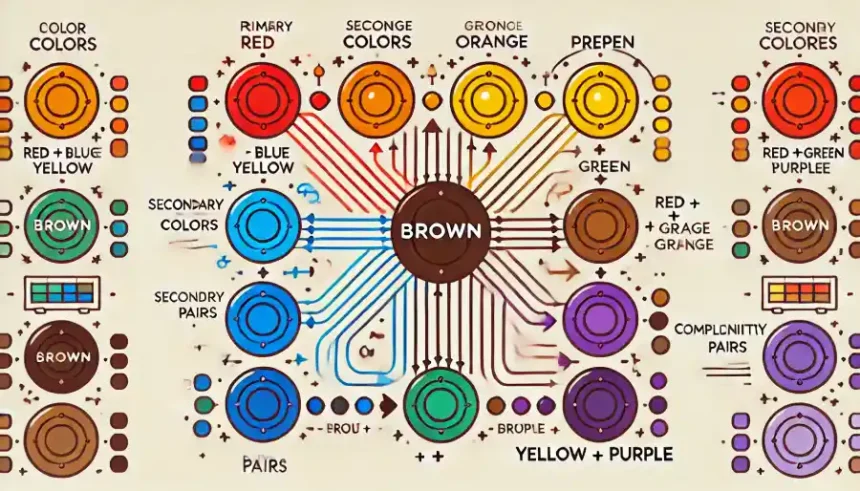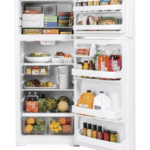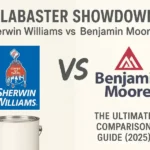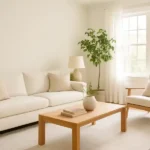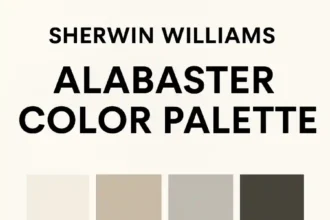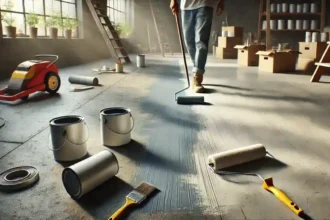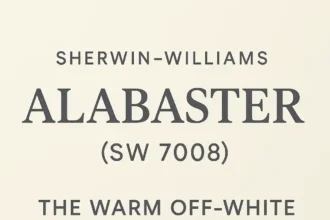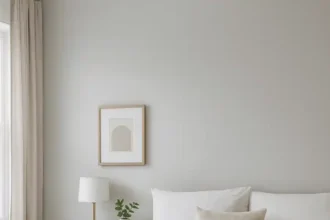Brown is one of the most versatile and widely used colors in art, design, and everyday projects. From warm earthy tones like chestnut to soft neutrals like taupe, brown offers a rich palette for creativity. But what colors make brown, and how can you create it using basic paints or digital tools? This comprehensive guide will answer those questions, explore the shades of brown, and provide tips for using it effectively.
What Colors Make Brown?
To understand how to make brown, we first need to explore the fundamentals of color theory.
Understanding the Basics of Color Theory
Brown is a tertiary color, meaning it is created by mixing primary or secondary colors. Here’s how you can create brown depending on your medium:
- Traditional Primary Colors (Red, Yellow, Blue):
- Mix equal parts of red, yellow, and blue to create a neutral brown.
- Adjust proportions to make lighter or darker shades.
- Complementary Colors:
- Mix complementary pairs (e.g., orange and blue, or red and green) to achieve different browns.
- RGB Color Model (Digital Design):
- Combine specific values of red, green, and blue (e.g., R:150, G:75, B:50) for SaddleBrown.
Why Does Brown Matter?
Brown offers balance, grounding your designs and creations. It’s the backbone of natural color palettes and an essential tool for expressing warmth and depth.
Popular Shades of Brown and Their Uses
Here’s a breakdown of some common brown shades, their RGB/HEX codes, and where they are commonly used:
| Shade Name | RGB Code | HEX Code | Mix of Colors | Use Cases |
| Beige | rgb(245, 245, 220) | #F5F5DC | White + Yellow + Brown | Neutral walls, minimalist interiors |
| Tan | rgb(210, 180, 140) | #D2B48C | Yellow + Brown + White | Furniture, natural textures |
| Khaki | rgb(195, 176, 145) | #C3B091 | Green + Yellow + Brown | Outdoor wear, military uniforms |
| Taupe | rgb(139, 133, 137) | #8B8589 | Gray + Brown | Modern design, elegant furniture |
| Sand | rgb(194, 178, 128) | #C2B280 | Yellow + White + Brown | Beach themes, casual décor |
| Buff | rgb(240, 220, 130) | #F0DC82 | Yellow + White + Tan | Clothing, upholstery |
| Caramel | rgb(255, 179, 102) | #FFB366 | Yellow + Brown + Red | Edible themes, warm color palettes |
| Camel | rgb(193, 154, 107) | #C19A6B | Yellow + Brown | Leather goods, shoes |
| Honey | rgb(240, 200, 110) | #F0C86E | Yellow + Orange + Brown | Rustic accents, kitchen themes |
| Wheat | rgb(245, 222, 179) | #F5DEB3 | Yellow + White | Farmhouse décor, soothing textiles |
| Chestnut | rgb(149, 69, 53) | #954535 | Brown + Red | Warm wood tones, vintage designs |
| Chocolate | rgb(123, 63, 0) | #7B3F00 | Red + Blue + Brown | Rich accents, desserts, artistic styles |
| Coffee | rgb(111, 78, 55) | #6F4E37 | Brown + Black | Rustic tones, café branding |
| Espresso | rgb(97, 39, 24) | #612718 | Brown + Black | Dark furniture, luxury themes |
| Mocha | rgb(150, 120, 90) | #96785A | Brown + Red + White | Coffee themes, cozy interior accents |
| Cappuccino | rgb(180, 150, 120) | #B49678 | Brown + White | Light textures, neutral furniture |
| Cognac | rgb(204, 105, 44) | #CC692C | Brown + Red + Yellow | Leather goods, sophisticated interiors |
| Amber | rgb(255, 191, 0) | #FFBF00 | Yellow + Orange | Jewelry, energy, bold highlights |
| Rust | rgb(183, 65, 14) | #B7410E | Red + Orange + Brown | Industrial design, rustic accents |
| Ochre | rgb(204, 119, 34) | #CC7722 | Yellow + Red + Brown | Earthy themes, pottery, warm interiors |
| Burnt Sienna | rgb(233, 116, 81) | #E97451 | Red + Yellow + Brown | Sunset palettes, artistic creations |
| Raw Umber | rgb(115, 74, 18) | #734A12 | Yellow + Green + Brown | Classic art, vintage styles |
| Dark Brown | rgb(101, 67, 33) | #654321 | Brown + Black | Dramatic contrasts, heavy furniture |
| Walnut | rgb(119, 63, 26) | #773F1A | Brown + Black + Red | Wood finishes, sophisticated furniture |
| Mahogany | rgb(192, 64, 0) | #C04000 | Red + Brown | Luxurious furniture, antique themes |
Practical Example: Home Decor
- Use light brown for a cozy, earthy look in living rooms.
- Incorporate chocolate brown for bold furniture accents.
Add beige for a subtle and calming effect in bedrooms.
Interactive Color Mixing Tool
Experiment with creating brown in real-time using our Color Palette Selector Tool! Adjust the RGB sliders to mix your own custom shades of brown and see the resulting color instantly.
Interactive Color Mixing Tool: Explore Brown
Adjust the sliders below to mix red, green, and blue values, or select from popular shades to see practical applications and tips.
Resulting Color:
RGB(150, 75, 50)
Color Name: SaddleBrown
Popular Shades of Brown
Practical Example: Home Decor
Tip: Choose “Light Brown” for a cozy look, or “Chocolate Brown” to add bold accents to furniture.
Step-by-Step Process
- Start by adjusting the sliders to mix your base brown.
- Add more red for warmth, yellow for brightness, or blue for a cooler tone.
- See the resulting shade and practical uses above.
How to Make Brown: Methods and Techniques
Creating brown can be as simple or as detailed as your project requires. Below are step-by-step methods for making brown.
1. Mixing Primary Colors
A classic way to make brown is by combining red, blue, and yellow. Here’s how:
- Start with equal parts of red, blue, and yellow paint.
- Mix thoroughly to create a base brown.
- Adjust the proportions to alter the tone:
- Add more yellow for a warmer, golden brown.
- Add more blue for a cooler, muted brown.
- Add more red for a rich, reddish-brown.
This method is ideal for creating a balanced, versatile brown.
2. Using Complementary Colors
You can also make brown by mixing complementary pairs:
- Blue + Orange: Produces a rich, balanced brown.
- Red + Green: Creates a deep, earthy brown.
- Yellow + Purple: Results in a neutral brown tone.
Each combination offers a unique shade, making this method especially useful for customizing colors in art and design.
3. Adjusting Shades
Once you have a base brown, you can tweak it to match your needs:
- Lighten Brown: Add white, yellow, or cream to create shades like tan or beige.
- Darken Brown: Add black, dark blue, or green for deeper tones like mahogany or chocolate.
Exploring Shades of Brown
Brown is not a single color but a spectrum of shades and tones. Let’s explore some popular variations.
Common Shades of Brown
- Tan: A light, warm brown achieved by adding white or yellow to the base.
- Beige: A pale, neutral brown with a touch of gray.
- Chestnut: A reddish-brown inspired by the color of chestnuts.
- Mahogany: A dark, reddish-brown tone often used in furniture and decor.
- Taupe: A grayish-brown with a cool, sophisticated undertone.
Mixing Specific Shades
Here’s how to achieve specific shades:
- Light Brown: Mix brown with white or yellow for a tan-like shade.
- Dark Brown: Add a small amount of black or blue for depth.
- Reddish Brown: Add extra red to create a warm, rich tone.
Digital Color Codes
For those working digitally, brown shades can be created using specific HEX or RGB codes:
- Light Brown: HEX #A52A2A, RGB (165, 42, 42)
- Dark Brown: HEX #654321, RGB (101, 67, 33)
Practical Applications of Brown
Brown’s versatility makes it a go-to choice for various creative and functional purposes.
1. Symbolism and Psychology
Brown symbolizes stability, warmth, and earthiness, making it ideal for creating comfortable and grounded designs. It is often used in:
- Interior Design: Walls, furniture, and decor.
- Fashion: Warm, neutral palettes that pair well with other colors.
- Branding: Logos and themes that convey reliability and tradition.
2. Pairing Brown with Other Colors
Brown pairs beautifully with a variety of hues:
- Warm Pairings: Gold, orange, and beige.
- Cool Pairings: Blue, green, and gray.
- Neutral Pairings: Cream, white, and black.
For example, brown and blue create a natural, calming palette, while brown and gold exude luxury and elegance.
3. Creating Brown in Different Mediums
- Food Coloring: Mix red, yellow, and blue food coloring to make brown icing. Adjust for a warmer or cooler tone.
- Digital Tools: Use complementary color sliders or HEX codes in graphic design software.
- Pencils and Pastels: Blend complementary colors directly on paper to achieve your desired shade.
Troubleshooting: Common Questions About Mixing Brown
Why Does My Brown Look Muddy?
If your brown appears dull or muddy, you may have:
- Overused black, which can overpower the mix.
- Mixed too many colors without balancing proportions.
To fix this, start with a fresh base and carefully adjust with small amounts of primary colors.
What Two Colors Make Purple, Green, or Orange?
Understanding these combinations can improve your ability to mix brown:
- Purple: Red + Blue
- Green: Blue + Yellow
- Orange: Red + Yellow
These secondary colors, when combined with their complements, form brown.
What Happens When Brown is Mixed with Other Colors?
- Brown + Red: Produces a reddish-brown.
- Brown + Blue: Results in a dark, muted tone.
- Brown + Yellow: Creates a light tan or golden brown.
FAQs About Brown
How to Make Brown with Paint?
Combine red, blue, and yellow paint in equal parts to create a base brown. Adjust with white, black, or other colors to refine the tone.
What Colors Go with Brown?
Brown pairs well with blue, gold, green, beige, and cream for versatile design palettes.
Can I Make Brown with Food Coloring?
Yes, mix equal parts red, yellow, and blue food coloring. For a warmer tone, add more yellow or red.
What Colors Create Tan or Beige?
Tan and beige are lighter shades of brown, made by adding white or cream to the base.
Conclusion
Creating brown is a simple yet rewarding process that unlocks a world of creative potential. Whether you’re mixing paints, experimenting with food coloring, or designing digitally, brown is a versatile and valuable hue that adds depth and richness to any project.
At Home Revista, we’re dedicated to inspiring and empowering your creativity with expert insights and tailored solutions. For more inspiration on how to use color effectively in your home, check out our guide on How to Use Color Theory and the Color Wheel to Transform Your Home Design. So, what will you create with brown today? Let the color-mixing journey begin!

